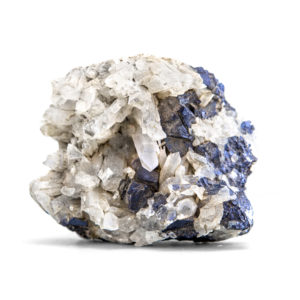Forget ‘Made in China.’ America’s Tech Challenge Is ‘Mined in China’

The United States is falling way behind in the global minerals race and the big loser could be the green energy sector, which is heavily reliant on minerals to power energy sources like wind and solar.
The U.S. Geological Survey’s annual Mineral Commodity Summaries report warns America is entirely reliant on foreign sources for more than half the critical minerals needed for its modern economy. That includes both green energy technologies of the near future, plus the batteries required to power laptops, cell phones, and other everyday items integral to everyday life.
And while the U.S. has agreements with friendly nations for these imports, China remains America’s top supplier — the nation that just sent a spy balloon through the skies over some of the nation’s top security areas.
“We have never been more dependent on China and others for the minerals that are absolutely essential to modern life,” said Katie Sweeney, executive vice president and chief operating officer of the National Mining Association. “The U.S. is stumbling when it comes to our supply chains. With each new announcement of a blocked mine or a foreign sourcing agreement with countries that have questionable labor practices, we are locking in our position of competitive weakness.”
Last year, the U.S. was 100 percent reliant on net imports for 51 nonfuel mineral commodities according to the Geological Survey. The report estimated the value of domestic metal mine production in 2022 was $34.7 billion, which was 6 percent lower than the revised value from 2021. The country’s capacity utilization for the metals mining industry dropped two percentage points from 2021 to 63 percent capacity last year.
The issue is not that the U.S. does not have the capability or resources to produce many of these minerals. The problem, according to mining advocates, is mine permitting takes an average of seven to 10 years.
“It takes forever to get a new permit. How crazy is that?” Energy Secretary Jennifer Granholm said last March at the CERAWeek energy conference. Her comments that she would streamline permitting for sources of minerals needed for electric vehicles “elicit[ed] loud applause,” Reuters reported at the time.
But while comments from Granholm and Jigar Shah, head of the Department of Energy’s Loan Program Office sounded encouraging, the Biden administration remains reluctant to approve new mining projects. Just this month, the U.S. Environmental Protection Agency denied permits for Pebble Mine in Alaska – a significant source of copper and gold – to protect salmon habitat.
The project would have mined up to 73 million tons of minerals per year, and Pebble Limited Partnership John Shively said the EPA’s action was “unlawful” and promised litigation over the denial.
Ian Lange, a faculty fellow at the Payne Institute for Public Policy at the Colorado School of Mines, bluntly assessed domestic production of minerals as “crappy.” Despite widespread acknowledgment among advocates of green energy that the U.S. cannot reach aggressive climate goals without critical minerals, Lange said many are more comfortable with outsourcing mining so they don’t have to see it happening – an advanced NIMBY-ism.
“The people who are supportive of clean energy but don’t want mining in the U.S. call it ‘friend-shoring’ where it’s sourced out to countries like Canada and Australia that do have environmental safeguards and labor standards,” he said.
The average time for permits in both of those countries is two to three years, according to the National Mining Association. But regardless of the good relationship the U.S. enjoys with those countries, China far surpasses them in production.
China is the largest processor of copper, nickel, cobalt, lithium, and rare earth minerals – all needed to power rechargeable batteries and other components of green technology, the association said. China is also planning 107 lithium-ion battery mega factories compared to nine in the U.S.; according to the mining association, that is the equivalent of China building one factory per week while the U.S. builds one every four months.
Increasing domestic production would meet two goals for the disparate groups that support mining and oppose it on environmental grounds: increasing economic development here at home.
“Both parties are interested in the same story of economic growth in the U.S.,” Lange said. “Low-income populations would a chance to expand [opportunities] because that’s where mineral deposits tend to be. But we’re missing out on the jobs and economic development that might come from developing a mine and supporting infrastructure.”
North Carolina has significant lithium deposits, and Idaho features large deposits of copper. In Minnesota, Twin Metals, which could produce approximately 30 million pounds of cobalt, and PolyMet, which could yield as much as 170 million pounds of nickel, are both stalled in the permitting process, the mining association said. And neither Resolution Copper in Arizona – a potential source of 25 percent of U.S. copper – nor Lithium Americas Thacker Pass in Nevada – the largest lithium deposit in the country – show signs of progress.
And then there’s the story from Maine, where the world’s richest hard rock lithium deposit was recently discovered, but state law forbids the mining procedures needed to extract it. Thanks to anti-mining laws, the $1.5 billion find may have to remain in the ground, and not in U.S. manufactured technology.
“We have tons of these minerals,” Lange said. “We have more than we’ll ever need but nobody likes a mine in their backyard.”
Please follow DVJournal on social media: Twitter@DVJournal or Facebook.com/DelawareValleyJournal



